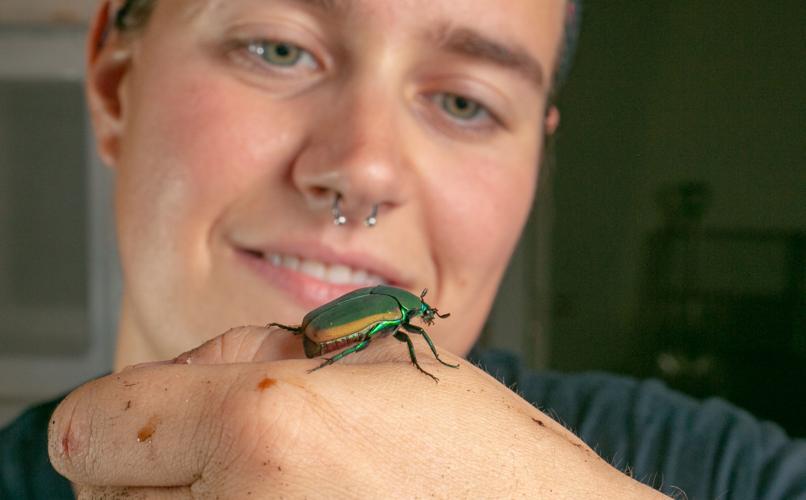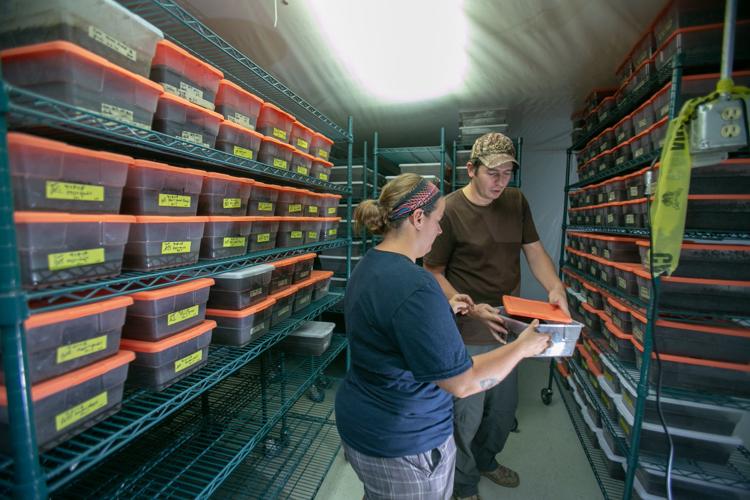Lobster was once barely considered a food, fit only for prisoners or the poor. Now, it’s a delicacy, and many wonder how it could ever have been considered disgusting.
Meck Slagle, a University of Arizona graduate student in entomology and insect science, feels the same way about insects.
“I had read a long time ago that the World Health Organization was saying, ‘Oh yeah, insects are the new way to go,’” Slagle said. “So I started raising Manduca, which is a caterpillar, in my closet.”
Now, Slagle is researching the most efficient way to raise high-quality insects for human consumption in the entomology lab of Goggy Davidowitz, UA professor and distinguished scholar in the department of entomology. Slagle’s research started with a chance encounter with Davidowitz while she was an undergraduate.
“She came to work in my lab on the project, and she’s amazing,” Davidowitz said. “When she said she wanted to do a master’s, I really wholeheartedly endorsed her.”
Now, a year into her research, Slagle has bins of fig beetle grubs that she’s raised for study. Kept in the lab near the campus Agricultural Center, Slagle said they’ll weigh about 4½ grams when fully grown.
“The idea is that we would make them purge their guts so there’s no substrate (dirt and compost) in them, and then you freeze them,” Slagle said. “You could cook them like shrimp, you could grind them up, you could do whatever you want.”
Grubs will purge within 24 hours of being removed from the substrate, according to Slagle. Right now, she’s focusing on establishing the colonies, but in December, she plans to get some grubs tested to determine the nutritional quality, which is an important step toward integrating them into the food industry.

UA graduate student Meck Slagle says insects, like this fig beetle, are a low-cost, accessible food resource.
“I relate crickets to the potato chips of the insect world, because they’re just kind of crunchy, but if we want people to eat insects in the future, how are we actually going to get them to replace their steak? Not with potato chips,” Slagle said. “We’re looking at grubs and caterpillars, things that are bigger and actually have some ‘beef’ to them.”
At the core of Slagle’s interest in this topic is environmentalism. Insects take less space and resources to raise, Slagle said. They don’t need added water, like vegetables do, because they get their water from the soil, air and food.
“The whole idea of our project is we are taking waste streams and feeding them to insects, so we’re trying to keep things out of landfill, whether it’s compost, rotting food, just what can we feed them that would just normally be thrown away,” Slagle said. “That way it’s not taking food out of our mouths, because with cows, we feed them corn that we could be eating.”
Another bonus to raising insects is a large part of the animal cruelty aspect of food production is removed while allowing for more efficiency, as insects take up far less space.
“Insects take such a small footprint … I have thousands, hundreds of thousands in this (lab),” Slagle said. “And there is no ‘slaughter,’ we just freeze them. The whole insect can be eaten, so there’s no need to ‘bleed’ them or any of the other horrific things that livestock go through during processing.”
Davidowitz said insects are also a low-cost, accessible resource. Insect farms can easily be located in urban environments, creating local options for consumers.
“You can even buy kits now to grow mealworms that sit on your kitchen counter,” Davidowitz said. “You can produce protein to add to your diet on a regular basis and it just sits on your counter.”

Slagle picks up a box of fig beetles at the UA entomology lab. “We’re looking at grubs and caterpillars, things that are bigger and actually have some ‘beef’ to them,” Slagle says.
Once they figure out the science, Slagle said there’s still the task of getting people on board. She pointed to chefs as the way to get North America over its insect-eating taboo.
“They’re the ones who are going to get creative with it and make it yummy, because if you pick up a beetle, you’re not just going to eat it,” Slagle said. “You don’t just walk out into a field and start gnawing on a cow. Chefs are people who take these ingredients and make them into delicious food.”
Another way to normalize eating insects is the Arizona Insect Festival, on Oct. 21. Slagle said her lab is raising the mealworms that will be stir-fried and offered to festival-goers. Slagle said mealworms have an earthy taste, similar to mushrooms.
“There might be crickets too,” Slagle said. “You can try them, we’ll also have fun activities like ‘pet a caterpillar.’ Please don’t eat it, but you can pet it.”
Davidowitz said while Slagle is the only graduate student in his lab working on edible insects, he’s working to expand the research and add classes that students can take, with the support of the College of Agriculture and various UA groups.
“Meck is very clever. She comes up with these really good solutions to things,” Davidowitz said. “It’s just a heck of a lot of fun.”







